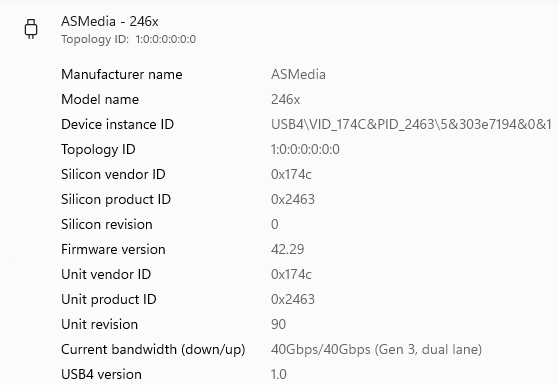I have to apologize to the review team at Lenovo. I’d told them I’d be sending back their splendid Yoga Pro 9(i) last Friday. Then I got an assignment from AskWoody to write about external, USB-attached NVMe (and other SSD) storage devices. So of course I had to a buy a current-gen 40 Gbps USB4 drive enclosure. Also, its inbuilt USB4 means Yoga Pro 9 stays on here at Chez Tittel while testing is underway. Sorry, Jeff and Amanda: I need to keep this beast a bit longer…
Why USB4 Means Yoga Pro 9 Stays On
Short answer: it’s my only PC/laptop with USB4 capability. And I want to research and write about same. And on the Yoga Pro 9i the first thing I observe is that while it has two USB-C ports, only one of them supports 40 Gbps throughput (the other is USB-C 3.2 and tops out at half that). This makes a big difference in read/write speeds. Ditto for cables: for best results you need a cable marked 40 Gbps or Thunderbolt 4, too. The device info for the MAIWO 40Gbps enclosure shows what needs to appear for fastest I/O:
The salient info is at the bottom: 40Gbps. It also detects a Gen3 NVMe SSD.
Over the next 10 days or so, I’ll be comparing enclosures, drives, and cables with related measurements. This should be interesting. But for now, let me observe that I paid US$70 for a 40Gbps NVMe enclosure yesterday. When I bought the previous generation (20Gbps) enclosures, the cheapest ones cost US$120 or thereabouts. It’s good that the technology is getting both faster and cheaper. I’m very interested to see how quickly Macrium Reflect can back up the Yoga Pro 9i with a fast SSD and this fast enclosure. Should be fun!
Top of the Heap? You tell me…
FWIW, Cale Hunt over at WindowsCentral just anointed the Lenovo Yoga 9i as the #1 best laptop for 2024. I’ve found it to be pretty stellar in my 5 weeks working with it so far. It’s been great at handling complex programs, lots of VMs, and both compute- and graphics-intensive workloads. Too bad it came out before Copilot + PC requirements were known. It’s close, but not quite at that level. Sigh.

